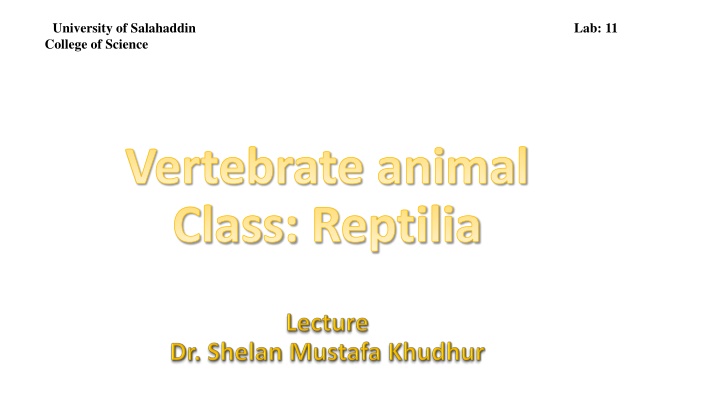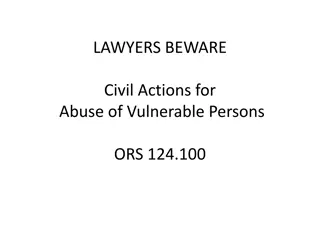
Fascinating World of Reptiles | University of Salahaddin College of Science
Explore the ancient class of organisms, Reptilia, at the University of Salahaddin College of Science lab. Learn about their evolution, characteristics, and classification, including their unique adaptations for life on land. Discover the diversity of reptiles, their cold-blooded nature, distinctive scales, and specialized features like pentadactyl limbs and typical cloaca.
Download Presentation

Please find below an Image/Link to download the presentation.
The content on the website is provided AS IS for your information and personal use only. It may not be sold, licensed, or shared on other websites without obtaining consent from the author. If you encounter any issues during the download, it is possible that the publisher has removed the file from their server.
You are allowed to download the files provided on this website for personal or commercial use, subject to the condition that they are used lawfully. All files are the property of their respective owners.
The content on the website is provided AS IS for your information and personal use only. It may not be sold, licensed, or shared on other websites without obtaining consent from the author.
E N D
Presentation Transcript
University of Salahaddin College of Science Lab: 11 Vertebrate animal Class: Reptilia
Introduction Class: Reptilia These were the first class of organisms to adapt to life on land. They are believed to have evolved from millions of years ago. There are about 10,000 different species of reptiles on earth. They are cold-blooded animals belonging to the phylum Chordata of Animal kingdom.
Characteristics of Reptilia Following are the important characteristics of the animals belonging to Class Reptilia: 1. These are creeping and burrowing terrestrial animals with scales on their body.
2. They are cold-blooded animals found in most of the warmer regions of the world.
4. The body is divided into head, neck, trunk, and tail. 5. Few of these shed the scales on their skin as skin cast.
7. They have two pairs of pentadactyl limbs, each bearing claws. Snakes are an exception. 8. A post-anal tail is present.
9. Except for snakes, all the reptiles have well-developed ears. 10. They possess a typical cloaca.
CLASSIFICATION CLASSIFICATION On the basis of presence or absence of certain openings in the temporal region of the reptilian skull the class Reptiles can be divided into five subclasses. Subclass II: EURYAPSIDA(Extinct) Subclass-III PARAPSIDA (Extinct) Sub-class IV SYNAPSIDA (Extinct)
Subclass I: ANAPSIDA Anapsid reptiles are those in which the dermal bones form a complete roof over the skull, Skull roof is solid, temporal openings are absent. Turtles, tortoises, and terrapins belong to this group.
Sub-class V DIAPSIDA: Skull with two temporal openings on either side separated by the bar of postorbital and squamosal bones. This subclass includes 4 orders
Scientific classification of snake Scientific classification of snake Domain: Kingdom: Animalia Phylum: Class: Reptilia Order: Squamata Eukaryota Chordata
Smell seems to be a snakes best thing . The snake analyzes scents by flicking (quick movement) its long tongue into the air to gather scent molecules, which are then transferred to the Jacobson s organ (The organ helps snakes hunt and track their prey) located inside its mouth. Most snakes have awesome eyesight. Tree-dwelling snakes have binocular vision. These snakes can focus both eyes on the same point.
The word snake is derived from old English snaca, meaning to crawl or to creep. some snakes kill their prey by injecting venom before eating it. A spitting cobra can spit venom at a perceived target about 3-7 feet away Snake sleep with their eyes open, and they lack eye lids. After a heavy meal , snakes tend to sleep for days even weeks.
Some poisonous snakes in Iraq Some poisonous snakes in Iraq
Saw Saw- -Scaled Viper ( Scaled Viper ( Echis Echis carinatus carinatus ) ) Desert Horned Viper (Cerastes Cerastes cerastes Macrovipera lebetina cerastes) lebetina) Lebetine Viper (Macrovipera Kurdistan Viper (Vipera Vipera raddei raddei kurdistanica kurdistanica) Desert Cobra (Walterinnesia aegyptia Walterinnesia aegyptia) Two-headed snake found in Kurdistan Region






















